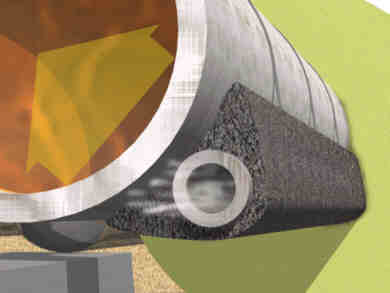.
Technical
Information
TRANSCALOR
heat conducting cement
.
| The TRANSCALOR -
Heat Conducting Cement Transcalor
- Heat Conducting Cement is an inorganic
and non-metallic material with high
thermal coductivity, that does not melt
or support combustion.
This compound, which is
pasty in its ready for use state, binds
to form a cement-like hardness following
the application procedure. Since the
linear shrinkage of TRANSCALOR - heat
conducting cement is minimal, excellent
resistance to thermal and mechanical
stressing is provided.
It is used for pipe heating
systems or tank heating systems which are
heated by means of external trace heating
pipes or electric heating cables. It can
also be used for corresponding cooling
systems.
The application area of the
TRANSCALOR - heat conducting cement
covers temperature ranges up to 700
degrees Celsius, what is sufficient for
the most heating systems.
| Content | TRANSCALOR - Heat
Conducting Cement | Home |
|
.
| Application
of TRANSCALOR - Heat Conducting Cement Viscous
materials, or materials with a higher
solidification point, are difficult to
convey or store. Since the transport of
these materials below specific
temperatures is not possible on an
economical basis, they are usually heated
by means of external accessory heating
pipes through which a heating medium
flows.
The contact surface area
between the accessory heating pipe and
product pipe, however, is rather small.
By applying the TRANSCALOR - heat
conducting cement, the contact surface
area between the round accessory heating
pipes and the product pipe is increased
and the heat transmission considerably
improved.
As a result, when compared
to the pipe trace heating system without
TRANSCALOR - heat conducting cement, the
number of required accessory heating
pipes can also be reduced.
The massive heat flow on the
surface covered with TRANSCALOR - heat
conducting cement continues in
circumference direction on the prodct
wall due to the good thermal
conductivity:

| Content | TRANSCALOR - Heat
Conducting Cement | Home |
|
.
| Consumption
and quantities When
using the TRANSCALOR - heat conducting
cement, it is important, that the heating
pipe is covered at least 6 mm high with
the cement and that no kinds of hollow
spaces ( e.g. air bubbles) are enclosed
in the TRANSCALOR - heat conducting
cement.
The food width must be at
least three times the value of the
external diameter of the heating pipe.
The use of the TRANSCALOR -
heat conducting cement results in the
following required quantity per metre of
pipe length:
External
Diameter trace heating pipe
|
appr.
Required quantity
Kg / m
|
Approximate
application width on product pipe
|
3/8 "
|
0,9 - 1,3
|
30 mm
|
1/2 "
|
1,1 - 1,5
|
40mm
|
3/4 "
|
1,3 - 2,0
|
58 mm
|
1 "
|
2,5 - 3,0
|
78 mm
|
TRANSCALOR -
heat conducting cement
is delivered ready for use.
Bundle: Hobbit: 17 Kg
- ca. 10 l
Specific weight:
prior to processing: ca. 1,8
following the drying process: ca. 1,7
| Content | TRANSCALOR - Heat
Conducting Cement | Home |
|
.
TRANSCALOR
- Heat Conducting Cement
Summary of the most important product
advantages:
- high thermal
conductivity and low temperature
conductivity
- good processing
proberties and adhesive property
- saving of one or
several trace heating pipes
possible due to the increase in
the size of the heat contact area
- also suitable for
electric heating systems
| Content | TRANSCALOR - Heat
Conducting Cement | Home |
|
Further
information fromTranscalor Verkaufskontor GmbH,
Rudolf-Diesel-Straße 11, D-28876 Oyten
| Contact |
.
|

